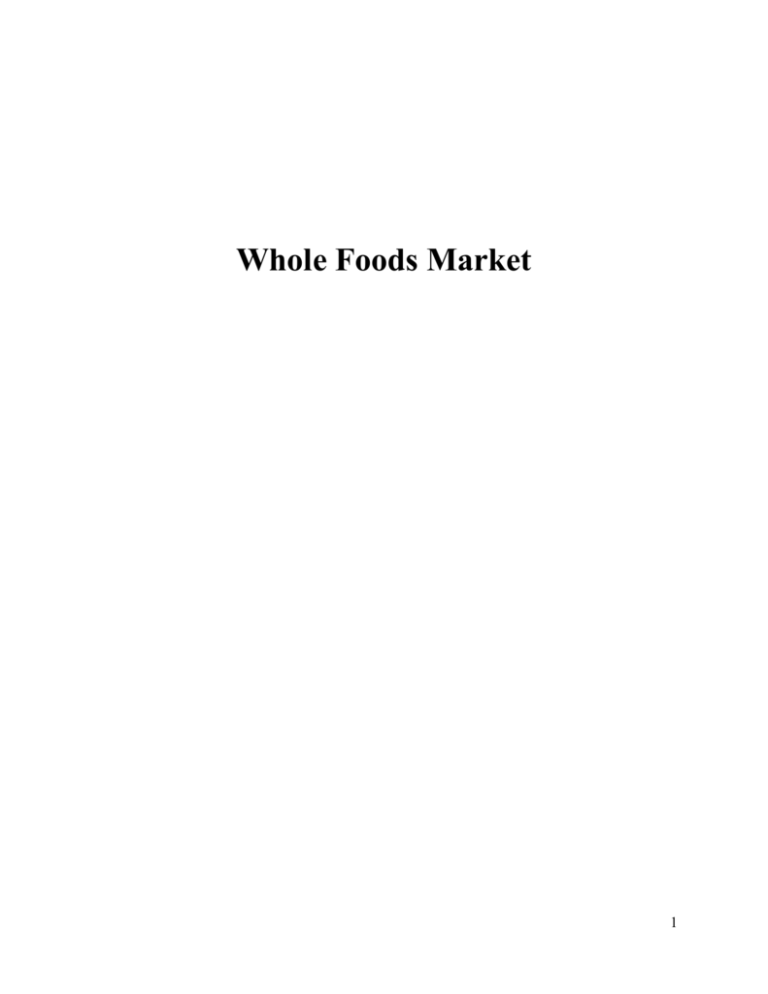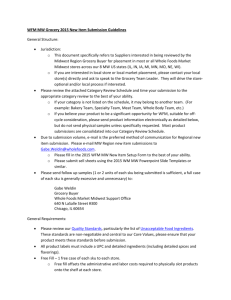Whole Foods Market Paper
advertisement

Whole Foods Market 1 Table of Contents INTRODUCTION......................................................................................................................... 3 SWOT............................................................................................................................................. 4 STRENGTHS .................................................................................................................................. 5 Broad Product Offerings and Rapid Distribution .................................................................. 5 Focused Growth Strategy ....................................................................................................... 5 Revenue Growth ...................................................................................................................... 6 WEAKNESSES ............................................................................................................................... 6 Product Recalls ....................................................................................................................... 6 International Operations ........................................................................................................ 6 Rental Agreements .................................................................................................................. 7 Pricing..................................................................................................................................... 7 OPPORTUNITIES ........................................................................................................................... 8 Changing Market Conditions.................................................................................................. 8 Political Interest and Regulation ............................................................................................ 8 THREATS ...................................................................................................................................... 8 Regulation ............................................................................................................................... 8 COMPETITION............................................................................................................................... 9 CURRENT STRATEGIES ........................................................................................................ 10 MARKETING STRATEGY ............................................................................................................. 10 EXPANSION STRATEGY .............................................................................................................. 10 MERCHANDISING STRATEGY ..................................................................................................... 11 FINANCIAL STRATEGY ............................................................................................................... 11 RECOMMENDATIONS............................................................................................................ 12 ADVERTISING AND COMPANY IMAGE ........................................................................................ 12 DIVERSIFICATION ....................................................................................................................... 12 PRIVATE LABELS ....................................................................................................................... 13 RESTAURANT PARTNERSHIP ...................................................................................................... 13 TECHNOLOGY TESTING STORE................................................................................................... 13 APPENDIX .................................................................................................................................. 14 REFERENCES ............................................................................................................................ 18 2 Introduction According to the Securities and Exchange Commission’s website, Whole Foods Market (WFM) is a retailer of natural and organic foods with one operating segment: natural and organic foods supermarkets (Primary NAICS: 445110 and Primary SIC: 5411). As of September 29, 2013, WFM operated 362 stores with 347 residing in 40 US states and the District of Columbia; 8 stores in Canada and 7 stores in the U.K. (http://www.sec.gov/investor/links.shtml) In addition, as of Sept. 29, 2013, WFM. had 26 leased properties and adjacent spaces that are not being utilized in operations. Refer to the Appendix, Section A for a complete list of stores by state, the District of Columbia, Canada and the U.K. as of Sept. 29, 2013. WFM provides a variety of natural and organic products with a focus on perishable foods. The product selection of WFM includes the following: o o o o o o produce and floral grocery, cheese, meat, seafood bakery, prepared foods and catering coffee, tea, beer, wine nutritional supplements, vitamins, body care lifestyle products including books, pet products, and household products WFM and its subsidiaries currently own 38 Trademarks. For a complete list of trademarks, refer to the Appendix, Section B. WFM has formulated and published a Declaration of Interdependence on their company website that defines the core values of the firm and describes WFM as a “…dynamic leader in the quality food business and is a mission driven company that aims to set the standards of 3 excellence for food retailers.” (http://www.wholefoodsmarket.com/mission-values/corevalues/declaration-interdependence) The core-values listed on the website include the ability to: o o o o o o o Sell the highest quality natural and organic products available Satisfy, delight and nourish customers Support Team Member happiness and excellence Open and timely information Create wealth through profits and growth Serve and support our local and global communities Practice and Advance environmental stewardship WFM was founded in 1978 as SaferWay in Austin, Texas by John Mackey and Rene Lawson. In 1980, Mackey and Lawson partnered with Craig Weller and Mark Skiles to merge with Clarksville Natural Grocery--with the intent of creating the first Whole Foods Market. (http://www.wholefoodsmarket.com/company-info) In 1984, WFM began an aggressive expansion throughout the US that included the opening of additional stores and the acquisition of other natural food stores in the targeted area. In 2002, WFM expanded into Canada and 2004 expanded to the UK with the acquisition of seven Fresh & Wild stores. SWOT The SWOT analysis (Strengths, Weaknesses, Opportunities, and Threats) is a broad framework of analysis that allows for the evaluation of the internal and external environment of a firm. The acronym SWOT is designed to reflect the ability to segregate internal and external examinations. Under this framework of analysis, a firm is evaluated by investigating the internal strengths and weaknesses of the firm. The objective is to exploit the strengths and minimize the weaknesses of the firm. The assumption is that management has the ability to influence or control the internal strengths and weaknesses of the firm. 4 Conversely, the opportunities and threats of the SWOT framework refer to the external environment and do not necessarily reflect conditions that management can directly control or influence. The objective of the external evaluation is to identify and pursue possible opportunities available and to hedge the firm against probable threats. (http://business.nmsu.edu/~dboje/sbc/pages/page3.html) The SWOT provided in this analysis is used to delve into the strengths, weaknesses, opportunities, and threats of WFM. Strengths The strengths evaluation of WFM includes an investigation of the broad product offerings and rapid distribution, focused growth strategy, and revenue growth. Broad Product Offerings and Rapid Distribution WFM has a product selection with a strong emphasis on perishable foods designed to appeal to a diverse customer base that includes individuals interested in both natural and organic foods as well as customers interested in fresh gourmet items. The product selection available in WFM stores include seafood, grocery, meat and poultry, bakery, prepared foods and catering, specialty (beer, wine and cheese), coffee and tea, nutritional supplements, vitamins, body care and educational products such as books, floral, pet products and household products. Focused Growth Strategy WFM management focuses on expansion, mainly through new store openings in new and existing trade areas. Management’s strategy to grow through identical store sales growth, acquisitions and new store openings has enabled WFM to grow at a compounded annual growth rate of 27% since 1991. (http://www.businessinsider.com/whole-foods-changing-prices-2013-5) 5 Revenue Growth WFM’s food strategy is well suited for the market conditions prevalent in the industry. The rapid growth in sales of natural and organic foods returned about $30 to $35 billion in revenue in 2009. (Case 2, Teaching Note, p. 9) In 2007, WFM reported net revenue of $6.6 billion; in 2011 the company reported net revenue of $10.1 billion, representing 11.22% annual growth per year. Analysts anticipate a continuation of growth and estimate 2016 revenues to yield $20 billion. Weaknesses The weaknesses evaluation of WFM includes an investigation of product recalls, international operations, rental agreements, and pricing. Product Recalls WFM has a history of recalling products (including WFM private label) found to contain salmonella E coli. Such recurrent product recalls negatively affect the brand image of the company, which in turn leads to low customer loyalty and results in a decrease in brand equity. International Operations The WFM stores in Canada and the US are not large enough to reach economies of scale in purchasing and logistics. The inability to yield economies of scale in stimulates the need for an increase in product pricing. The competition has a competitive advantage with the more efficient network structure that allows for a decrease in product pricing. Another weakness for WFM resides in the investment portfolio of existing operations. Although WFM is expanding outside the US, 347 of the 362 stores in WFM’s portfolio are 6 located in the US which represents more than 95% of total holdings in a single market. The existing portfolio distribution makes WFM highly sensitive to the US economic market. Rental Agreements There are two kinds of accounting methods for leases: operating and capital lease. An operating lease is treated like a rental agreement where payments are considered operational expenses and the asset being leased remains off the balance sheet. In contrast, a capital lease resembles a loan, in that the asset considered owned by the lessee so it remains on the balance sheet. The accounting treatment for capital and operating leases is different, and can have a significant impact on taxes owed by the business. (Ely, 1995) WFM has many obligations under certain capital leases for facilities and equipment. The capital leases are subject to the laws explained above and therefore directly affect the company’s financial position. The rental expense charged to operations under operating leases for financial years 2010, 2009 and 2008 was approximately $303.5 million, $281.9 million and $257.5 million, respectively. Increasing rental expenses, affect company’s profitability. Pricing A major weakness to WFM is that in general, individuals view organic food as high priced. (http://www.scientificamerican.com/article/organic-still-a-small-slice-of-the-pie/). WFM’s weak distribution network in Canada and the UK as well as the existing image of high priced organic food in the US are barriers to WFM’s ability to achieve economies of scale. If WFM is to effectively compete with Kroger, Safeway, and Walmart; it must invest heavily in logistics abroad and brand image in the US. (http://www.businessweek.com/articles/2013-0508/whole-foods-profits-by-cutting-whole-paycheck-reputation). 7 Opportunities The opportunities evaluation of WFM includes an investigation of changing market conditions and political interest and regulation. Changing Market Conditions There is increasing amount of customers, who are becoming interested in natural and organic foods as part of a healthy lifestyle. The global sales of organic products grow every year and present opportunities for development and expansion in the area of natural and organic foods in mainstream customer markets. (http://www.dailyherald.com/article/20140302/business/140309980/) Political Interest and Regulation There are new USDA standards for labeling organic food products sold in grocery, which presents an opportunity for WFM to promote the merits of organically grown products to consumers. The Michelle Obama’s platform of healthy nutrition presents a significant opportunity to WFM. Michelle Obama has been very active in her Let's Move Campaign that reflects concerns about obesity and the quality of the American diet. Threats The threats evaluation of WFM includes an investigation of regulation, and the competitive environment. Regulation As the company operates in the natural and organic foods market, its stores and products are subject to several laws and regulations relating to health, sanitation and food labeling. Several federal agencies and departments including the Food and Drug Administration, the 8 Federal Trade Commission, the Consumer Product Safety Commission, the United States Department of Agriculture, and the Environmental Protection Agency set critical standards for the manufacture, processing, formulation, packaging, labeling and advertising of products. Failure to comply with these standards could result in penalties and seizure of marketing and sales licenses. These regulations also result in additional compliance costs, which could reflect in reduced margins. In addition, WFM is subject to differing regulated markets in Canada and the UK. Competition Food retailing is a large, intensely competitive industry. Whole Foods Market's competes with local, regional, national and international conventional and specialty supermarkets, natural foods stores, warehouse membership clubs, smaller specialty stores, farmers' markets, and restaurants. Most of these stores carry similar products, which means that loss of sales and profits are highly dependent on price and quality of products and loyalty of consumers. Based on the financial statements provided to the Securities and Exchange Commission, the top three competitors of WFM are Walmart, Safeway, and Kroger. The gross margins of these competitors are: Competitors Gross Margin 30 20 10 0 Gross Margin Wal-Mart Stores, Inc. Kroger Co. Safeway Inc. 24.82 20.56 26.27 9 WFM's 3 and 5 year compound annual growth rate for revenues is stronger than Kroger, Safeway, and Walmart. However, Walmart's revenue from 2012 to 2013 was more stable than WFM. Refer to the Appendix section (C ) for details. In addition to the existing competitive market, many other supermarkets are beginning to enter into the organic market and are offering healthy alternatives to mainstream customers. Current Strategies Marketing Strategy Whole Foods Market spent very little money on advertising itself. The advertising fee is 0.5% of revenues, which is a much smaller portion compare to other companies. Whole Foods Market advertises itself mainly through Word-of-Mouth and social media such as: Facebook, Twitter, Flickr, blog, e-newsletter and Pinterest. In addition, it spends most of marking budget on in-store signage and local events. All these methods aims at turn highly satisfied customers into advocates for Whole Foods. Expansion Strategy About 50% of the Whole Foods Market’s store bases had come from acquisitions. The company has acquired 134 stores through 15 acquisitions. The biggest and most important acquisition is the acquisition of Wild Oats Market. The sizes range from 35,000 to 50,000 square feet. We also have three “Showcase” or “Flagship” stores (58,000 to 78,000 square feet) in New York, Los Angeles, and Chicago. Current strategy focus on acquiring smaller size of stores (12,000 to 44,000 square feet) to enter smaller geographic market areas, which have only enough potential customers to support the business. Whole Foods Market is focused on the right sized store for each location. While 10 Whole Foods Market's larger-format stores have a strong presence in dense urban areas, the company's smaller stores have the potential to generate great returns as well. This new expansion strategy is expected to result in lower cost for both per-store and per-square-foot. Decreasing the fixed cost can help Whole Foods have more advantage on price setting. Merchandising Strategy The layout of each Whole Foods store was customized to fit the particular site and building configuration and to best show off the particular product mix chosen for that store’s target clientele. Colorful décor is used and products are displayed in an attractive manner. Strong presentation of stores, which can be shown by bright colors, hand-stacked fruits, quality of foods, customer service, wide aisles and cleanliness Information “taka action” center, siting-down eating section, cooking classes and chef in the kitchen. Financial Strategy In 2007 Whole Foods reported net revenue of $6.6 billion; in 2011 the company reported net revenue of $10.1 billion, representing 11.22% year over year annual growth, a tremendous feat that is highly anticipated to continue into the future as some analysts’ estimates put 2016 net revenues at nearly $20 billion. The company currently pays out quarterly dividends of $0.20, which annualized puts the dividend as yielding 0.87%, and while this may seem insignificant, this dividend nearly matches what you could get in any saving account. Institutional investors, such as pension plans, hold 85% of shares outstanding and these positions show the support long-term and big-money investors have in the company and its future. 11 Recommendations Advertising and Company Image We will focus on expanding its customer base by changing the image of organic products. According to industry estimates, the sales of organic food increased three fold since 2000 to reach $25 billion in 2010. Organic sales rose 5% in 2010, at a higher rate than the overall food industry in the US which grew at only 2%. This trend is likely to continue in the future. The White House’s healthy lifestyle agenda as expressed through Michelle Obama’s Let's Move Campaign is helping expand and alter the perception of healthy eating in the US and presents WFM with an opportunity to capitalize on the free marketing strategy implemented by the Obama Administration. WFM should try to coordinate with the Obama Administration in the effort to change America’s eating habits. We will increase advertising budget from 0.4% to the industry average of 1.5%. Weekly store advertisements should focus on shedding the Whole Paycheck nickname by advertising weekly specials and low prices. The recommended focus of the national campaign is on linking the name, Whole Foods and organic produce with low prices. Diversification We will diversify its investment portfolio and continue to expand abroad. Currently WFM holds more than 95% of its total holdings in the US. It is the recommendation that WFM aggressively invest in foreign markets and diversify operational locations. In addition, WFM should expand its distribution network abroad. WFM is burdened with higher shipping costs than competitors in foreign markets and cannot effectively or efficiently compete with the absence of a logistics network. 12 Private Labels We will focus on selling our private brands (365 Everyday Value and 365 Organic brands). Private label products in the US are witnessing strong growth in sales. In 2010, private label products accounted for nearly 20% of the dollar share and more than 20% of the unit share in stores in the US. WFM total private label sales accounted for approximately 11% of its retail sales in FY2010 and FY2009. This should be brought up to industry averages. Restaurant Partnership We will seek out partnerships with “healthy” restaurants and seafood restaurants. For example, we could partner with Red Lobster to be their supplier of fresh fish. These partnerships will benefit both companies by combining distribution networks which would lower fossil footprint further enhancing companies commitment to environment. Technology Testing Store We will use this store to test new concepts, ideas, and new technologies and look for ways to revolutionize the shopping experience. If these are good enough and the customers respond well to the ideas, it gets rolled out to other super markets. An example would be to utilize current radio tagging technology and robot technology. All goods would be tracked coming in and going out of store and then could be automatically re-stocked. Other technologies which could be tested could be drone delivery service feasibility to development of apps for nutrition. 13 Appendix (A) Number of WFM stores by state, the District of Columbia, Canada and the U.K. as of Sept. 29, 2013: Alabama Arizona (7) Arkansas California (73) Canada (8) Colorado (19) Connecticut (9) District of Columbia (4) Florida (19) Georgia (9) Hawaii (3) Idaho Illinois (18) Indiana (3) Iowa Kansas (2) Kentucky (2) Louisiana (3) Maine Maryland (8) Massachusetts (28) Michigan (6) Minnesota (6) Missouri (2) Nebraska Nevada (5) New Jersey (10) New Mexico (4) New York (12) North Carolina (10) Ohio (6) Oklahoma (2) Oregon (7) Pennsylvania (10) Rhode Island (3) South Carolina (3) Tennessee (4) Texas (21) U.K. (7) Utah (4) Virginia (10) Washington (7) Wisconsin (2) 14 (B) Trademarks owned by WFM or its subsidiaries Whole Foods Market the Whole Foods Market logo 365 Everyday Value; the 365 Everyday Value logo AFA Allegro Coffee Company America's Healthiest Grocery Store ANDI Awesome Eats Bread & Circus Capers Community Market Dark Rye; Eco-Scale Fresh & Wild Fresh Fields Grab & Give Greenlife Grocery Green Mission Harry's Farmers Market Health Starts Here Ideal Market Improving Lives with Every Purchase Merchant of Vino Mrs. Gooch's Vine Buys Wellspring Whole Baby Whole Cities Foundation The Whole Deal Whole Foods Whole People Whole Planet Whole Journeys Whole Kids Whole Kids Foundation Whole Planet Foundation Whole Ranch Whole Trade. Co. 15 (C ) Whole Foods Market, Inc. (NMS: WFM) Income Statement Compound Annual Growth Rate 3 Year 5 Year 09/29/2013 09/30/2012 Variance 01/19/2014 07/07/2013 Variance USD USD USD % USD USD USD % Revenues 12,917,000,00 0 11,698,828,00 0 1,218,172,00 0 10.41 4,239,000,000 3,058,000,000 1,181,000,000 38.62 0.09 0.1 Direct Costs 8,288,000,000 7,543,054,000 744,946,000 9.88 2,754,000,000 1,939,000,000 815,000,000 42.03 0.08 0.09 Gross Profit Item 4,629,000,000 4,155,774,000 473,226,000 11.39 1,485,000,000 1,119,000,000 366,000,000 32.71 0.09 0.11 Taxation 343,000,000 286,471,000 56,529,000 19.73 101,000,000 88,000,000 13,000,000 14.77 0.18 0.27 Net Income EPS Continuing Basic 551,000,000 465,573,000 85,427,000 18.35 158,000,000 142,000,000 16,000,000 11.27 0.17 0.3 1.48 1.28 0.2 15.63 0.42 0.38 0.04 10.53 0.15 0.28 EPS Net Basic EPS Continuing Diluted 1.48 1.28 0.2 15.63 0.42 0.38 0.04 10.53 0.15 0.28 1.47 1.26 0.21 16.67 0.42 0.38 0.04 10.53 0.15 0.28 EPS Net Diluted 1.47 1.26 0.21 16.67 0.42 0.38 0.04 10.53 0.15 0.28 02/02/2013 01/28/2012 Variance 11/09/2013 05/25/2013 Variance USD USD USD USD USD USD 96,751,000,00 0 76,858,000,00 0 19,893,000,00 0 90,374,000,00 0 71,494,000,00 0 18,880,000,00 0 6,377,000,00 0 5,364,000,00 0 1,013,000,00 0 22,505,000,00 0 17,889,000,00 0 30,043,000,00 0 23,856,000,00 0 4,616,000,000 6,187,000,000 7,538,000,000 5,967,000,000 1,571,000,000 125,000,000 266,000,000 299,000,000 481,000,000 Kroger Co. (NYS: KR) Income Statement Item Revenues Direct Costs Gross Profit Taxation 794,000,000 247,000,000 547,000,000 Net Income EPS Continuing Basic 1,497,000,000 602,000,000 895,000,000 2.78 1.01 1.77 EPS Net Basic EPS Continuing Diluted 2.78 1.01 1.77 2.77 1.01 1.76 EPS Net Diluted 2.77 1.01 1.76 12/31/2013 12/29/2012 Variance USD USD USD Revenues 36,139,100,00 0 44,206,500,00 0 Direct Costs 26,645,100,00 0 32,486,500,00 0 9,494,000,000 11,720,000,00 0 89,700,000 262,200,000 Net Income EPS Continuing Basic 3,507,500,000 596,500,000 0.96 2.28 -1.32 EPS Net Basic EPS Continuing Diluted 14.53 2.41 12.12 0.95 2.27 -1.32 EPS Net Diluted 14.38 2.4 11.98 % 7.06 7.5 5.37 221.4 6 148.6 7 175.2 5 175.2 5 174.2 6 174.2 6 % Compound Annual Growth Rate 3 Year 5 Year -25.09 0.06 0.05 -25.01 0.06 0.06 -25.39 0.03 0.03 -141,000,000 -53.01 0.1 0.02 -182,000,000 -37.84 0.1 0.04 0.58 0.93 -0.35 -37.63 0.17 0.08 0.58 0.93 -0.35 -37.63 0.17 0.08 0.57 0.92 -0.35 -38.04 0.17 0.08 0.57 0.92 -0.35 -38.04 0.17 0.08 Safeway Inc. (NYS: SWY) Income Statement Item Gross Profit Taxation 8,067,400,00 0 5,841,400,00 0 2,226,000,00 0 -172,500,000 2,911,000,00 0 Compound Annual Growth Rate 3 Year 5 Year 12/31/2013 06/15/2013 Variance % USD USD USD % 18.25 10,314,300,00 0 8,696,100,000 1,618,200,000 18.61 -0.06 -0.02 17.98 7,583,900,000 6,414,800,000 1,169,100,000 18.23 -0.06 -0.02 2,730,400,000 2,281,300,000 449,100,000 19.69 -0.07 -0.04 59,600,000 32,400,000 27,200,000 -0.37 -0.09 3,314,400,000 8,400,000 3,306,000,000 83.95 39357.1 4 0.89 - -0.14 - 18.99 65.79 488.0 1 57.89 502.9 58.15 499.1 7 0.42 0.24 0.18 75.0 13.73 0.03 13.7 45666.7 1.14 - 0.41 0.24 0.17 70.8 -0.14 - 13.58 0.03 13.55 45166.7 1.13 - Wal-Mart Stores, Inc. (NYS: WMT) Income Statement 16 Item Revenues Direct Costs Gross Profit Taxation Net Income EPS Continuing Basic 01/31/2014 01/31/2013 Variance USD USD USD 01/31/2014 07/31/2013 Variance USD USD USD 476,294,000,0 00 358,069,000,0 00 118,225,000,0 00 469,162,000,0 00 352,488,000,0 00 116,674,000,0 00 7,132,000,00 0 5,581,000,00 0 1,551,000,00 0 116,945,000,0 00 87,455,000,00 0 29,490,000,00 0 12,761,000,00 0 10,516,000,00 0 1.33 129,706,000,0 00 97,971,000,00 0 31,735,000,00 0 8,105,000,000 16,022,000,00 0 7,981,000,000 16,999,000,00 0 124,000,000 1.55 2,249,000,000 -977,000,000 -5.75 4,431,000,000 4.87 5.04 -0.17 -3.37 1.34 1.24 0.1 % 1.52 1.58 % Compound Annual Growth Rate 3 Year 5 Year 10.91 0.02 0.03 12.02 0.02 0.03 2,245,000,000 7.61 0.02 0.03 2,025,000,000 224,000,000 11.06 0.01 0.03 4,069,000,000 362,000,000 8.9 0.01 0.02 8.06 0.02 0.05 EPS Net Basic EPS Continuing Diluted 4.9 5.04 -0.14 -2.78 1.37 1.24 0.13 10.48 0.03 0.06 4.85 5.02 -0.17 -3.39 1.34 1.24 0.1 8.06 0.02 0.05 EPS Net Diluted 4.88 5.02 -0.14 -2.79 1.36 1.24 0.12 9.68 0.03 0.06 17 References Case 2 “Whole foods Market in 2010: Vision, Core Values, and Strategy” 2010.Web. March 25, 2014 Retrieved from: https://www.bsg-online.com/ Case 2 Teaching Note “Whole Foods Market in 2010: Mission, Core Values, and Strategy” 2010. Web. March 25, 2014 Retrieved from: https://www.bsg-online.com/ “Whole Foods Market” 2014. Web. March 25, 2014 Retrieved from: http://www.wholefoodsmarket.com/ “Whole Foods Market Mission & Value” 2014. Web. March 25, 2014 Retrieved from: http://www.wholefoodsmarket.com/mission-values “Whole Foods Market About Our Products” 2014. Web. March 25, 2014 Retrieved from: http://www.wholefoodsmarket.com/about-our-products “Whole Foods Market Company INFO” 2014. Web. March 25, 2014 Retrieved from: http://www.wholefoodsmarket.com/company-info “Whole Foods Market Annual Reports” 2014. Web. March 25, 2014 Retrieved from: http://www.wholefoodsmarket.com/company-info/investor-relations/annual-reports Kirsten M. Ely, “Operating Lease Accounting and the Market’s Assessment of Equity Risk” 2014. Book. March 25, 2014 Retrieved from: Journal of Accounting Research, Vol.33,2 Page 397 -415 18 19





